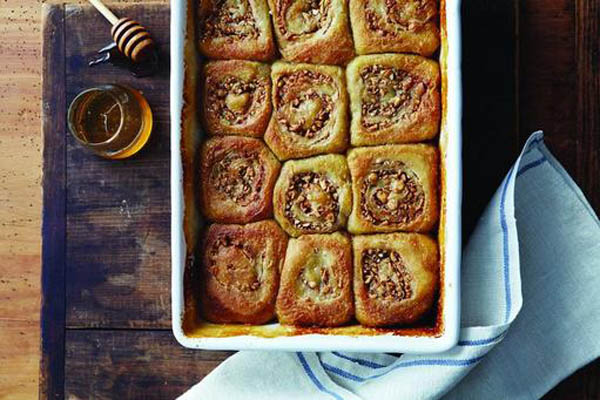 Honey Cashew Morning Buns
Honey Cashew Morning Buns
Recipe and headnote excerpted from Baking With Less Sugar (Chronicle Books, 2015). —Joanne Chang From: food52.com Makes 12 buns.
For the bun dough:
240grams (1 cup) water, at body temperature (when you put your finger in it, it should feel neither cold nor hot)
1/2teaspoon active dry yeast or 3 grams (0.1 ounces) fresh cake yeast
350 grams (2 1/2 cups) unbleached all-purpose flour, plus up to about 35 grams (1/4 cup) more, if needed
1 1/4teaspoons kosher salt
50grams (1/4 cup) olive oil or mild vegetable oil
Honey Goo
115grams (1/2 cup) unsalted butter
170 grams (1/2 cup) honey
120 grams (1/2 cup) heavy cream
120grams (1/2 cup) water
1/2teaspoon kosher salt
Bun Filling
240grams (2 cups) raw unsalted cashews, chopped
115grams (1/2 cup) unsalted butter, very soft
2tablespoons ground cinnamon
To make the dough: Lightly oil a large bowl and set it aside. In the bowl of a stand mixer fitted with the dough hook attachment, combine the water and yeast and let sit for 20 to 30 seconds to allow the yeast to dissolve and activate. Dump the flour and salt onto the yeast mixture, and carefully turn the mixer onto low speed. Let the dough mix for about 10 seconds. (To prevent the flour from flying out of the bowl, turn the mixer on and off several times until the flour is mixed into the liquid, and then keep it on low speed.) When the dough is still shaggy looking, drizzle in the olive oil, aiming it along the side of the work bowl to keep it from splashing and making a mess.
With the mixer still on low speed, knead the dough for 4 to 5 minutes, or until it is smooth and supple. The dough should be somewhat sticky but still smooth, and have an elastic, stretchy consistency. If it is much stiffer than this, mix in 2 to 3 tablespoons water; if it is much looser than this, mix in 2 to 3 tablespoons flour.
Transfer the dough to the oiled bowl. Cover the bowl with a piece of plastic wrap or a damp lint-free cloth. Place the bowl in a draft-free, warm place (78 to 82° F [25 to 28° C] is ideal; an area near the stove or in the oven with only the pilot light on is good) for 2 to 3 hours. The dough should rise until it is about double in bulk. (This is called proofing the dough.)
Meanwhile, make the honey goo: In a medium saucepan, melt the butter over medium heat and whisk in the honey, cream, water, and salt. Remove the pan from the heat and let the goo cool for about 30 minutes before using, or until room temperature. The goo can be stored in an airtight container in the refrigerator for up to 2 weeks.
To make the filling: Place a rack in the center of the oven and preheat to 350° F (175° C). Put the cashews on a baking sheet and toast for 8 to 10 minutes, or until lightly toasted. Turn off the oven and set the cashews aside to cool.
Punch down the dough to deflate it—literally give it a punch in the center of the puffy dough, which will allow you to roll it out more easily. On a floured work surface, roll out the dough into a 12-inch (30-centimeter) square about 1/4-inch (6-millimeter) thick. It will be a bit stretchy and it may spring back, but keep rolling gently until it roughly holds its shape.
In a small bowl, with a wooden spoon, mix together the butter, cinnamon, and toasted cashews for the filling. Spread this mixture evenly over the entire surface of the dough square.
Using your hands and starting from the top of the square, and working your way down, roll the dough loosely like a jelly roll until the entire sheet is rolled up. Using a sharp knife, trim both edges of the dough roll about 1/4 inch (6 millimeter) to even out the ends. Using a bench scraper or a chef’s knife, cut the roll into 12 equal pieces, each about 1-inch (3-centimeter) thick. (At this point, the unbaked buns can be tightly wrapped in plastic wrap—either individually or stack them all and wrap as a tower—and frozen for up to 1 week. When ready to bake, remove the buns from the freezer. Leave them wrapped and thaw in the refrigerator overnight, or at room temperature for 2 to 3 hours; proceed as directed.)
Pour the goo into a 9- by 13-inch (23- by 33-centimeter) baking pan. Place the buns in the pan, evenly spaced. If some of the buns have become oblong or oddly shaped from the cutting and moving around, feel free to arrange them once they are in the pan into round spirals. Cover the pan loosely with plastic wrap and let the buns proof at warm room temperature (78 to 82° F [25 to 28° C] is ideal; an area near the stove or in the oven with only the pilot light on is good) for 1 to 2 hours, or until the dough is puffy, pillowy, and soft and the buns are touching.
About 15 minutes before the buns are ready to bake, place a rack in the center of the oven and preheat to 400° F (205° C).
Bake for 40 to 50 minutes, or until the buns are pale and light golden brown. Remove from the oven and let cool in the pan on a wire rack for 10 to 20 minutes.
Using a spatula, invert the buns, one at a time, onto a serving platter. Serve warm. (These are best served warm or within 4 hours of baking. You could make them one day and serve them the next after warming them in a 300° F (150° C) oven for 6 to 8 minutes.)


